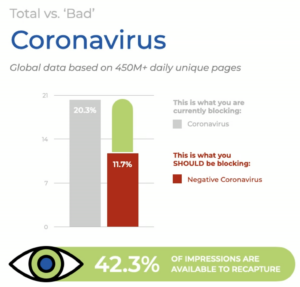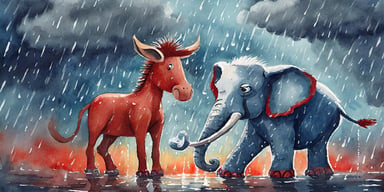In the world of digital advertising, during times of crisis, there’s a predictable pattern where advertisers go into protection mode to preserve brand safety. The response is understandable, especially given the very real human concerns associated with the current coronavirus (COVID-19) pandemic. You want to be sensitive to what’s happening, which usually involves a significant shift or reduction in advertising.
Recently, our partner MediaMath invited Alex White, COO of Peer39, to have a conversation about the challenges advertisers are facing right now in the face of an active global pandemic. Danny Sepulveda, SVP for Policy & Advocacy at MediaMath, hosted Alex as part of their Digital Dialogues webinar series. Together, Alex and Danny discussed the state of advertising and content in the time of coronavirus, and provided important recommendations around “A New Normal for Brand Safety.”
The 3 phases of coronavirus content
In a recent blog post, we outlined the three phases of content about coronavirus and the impact on advertisers with each phase:
- In the first phase, advertisers became aware of the problem and adopted a coronavirus = bad avoidance approach, setting up custom keyword blocklists.
- In the second phase, which we’re currently in, there’s a shift in the content from news about outbreaks, deaths, and shortages to coverage about how to live in this new reality.
- In the third phase, we’ll start to see more about the humanity of this situation as the new normal sinks in and stories about compassion and community begin to surface.
The big challenge right now: Advertisers have taken steps to ensure brand safety by blocking coronavirus and related keywords, a blunt protective measure that comes at the cost of missed opportunities.
Finding a path for advertisers during each phase of coronavirus
Given the shift in content during phase two as well as the anticipation of phase three, advertisers can use contextual targeting to shift away from blocking all coronavirus content. And the data supports advertisers maintaining activities during this time.
According to Kantar’s COVID-19 Barometer, only 8% of consumers think brands should stop running ads. What’s more, Kantar/BrandZ analysis following the 2008 economic crisis indicated brands that remained strong recovered 9 times faster.
 Furthermore, when analyzing over 450 million daily unique pages of content each day, we found that while 20.3% of content mentions coronavirus, only 11.7% of the content is Negative for Coronavirus. This means you can recapture 42.3% of impressions that are lost by blocking all coronavirus.
Furthermore, when analyzing over 450 million daily unique pages of content each day, we found that while 20.3% of content mentions coronavirus, only 11.7% of the content is Negative for Coronavirus. This means you can recapture 42.3% of impressions that are lost by blocking all coronavirus.
The picture looks even brighter when you consider content by category, as Alex shows in the webinar, sharing the percentage of safe coronavirus content that would allow you to recapture impressions in categories such as news, personal finances, and sports. These are only a few examples, but there is safe content available in every content category.
We’re in phase two and starting to see glimpses of phase three, and we know this situation isn’t going away quickly. Since keyword blocking goes too far, we developed a negative category that gives you access to a nuanced approach that gives you the ability to reach your audience while protecting yourself from content that’s negative for coronavirus. This effectively unlocks a deluge of impressions on safe, high-quality content when you need it most.
How to advertise safely during coronavirus: 2 takeaways
This new reality has spurred an influx of content about living through a pandemic, including stress relief, cooking, remote work, home learning, and so much more that addresses the everyday changes we’re living through. Eventually, we’ll see a new stream of content about communities coming together, heroes emerging, sick people recovering. And you want to be able to access the impressions for this kind of content, not block them.
Furthermore, when brands continue running ads on safe coronavirus content, it serves to maintain a healthy ecosystem where high-quality, ad-supported content can thrive instead of the alternative.
So, how do you keep your brand safe and strong during this pandemic?
- Adjust your approach to expand the available pool of impressions. In the webinar, Alex provides four recommendations for advertisers to use when evaluating and executing on their advertising strategy as the situation with coronavirus evolves. These recommendations cover everything from keyword blocking to categories to contextual targeting and messaging.
- Match your message to the moment. The ads you were running before coronavirus may not resonate with your audience today. The ads you run today may not resonate in a week or a month from now. With the situation evolving so quickly, brand safety requires keen attention to what your ad communicates. Hotels.com is a good example of taking a pre-coronavirus ad series and adjusting the story to fit today’s reality.
Watch the full webinar today to learn more about how to benefit from safe coronavirus content.
More Posts

Navigating (or Staying Away From) the Political Media Storm During the 2024 Presidential Election
In the ever-evolving landscape of political media, the 2024 Presidential election stands out as a pivotal moment, marked by extensive candidate coverage, heated debates on crucial social and political issues, and an unprecedented outpouring of content. Brands, political campaign teams, and advertisers each need to know how to effectively navigate this political media storm while ensuring alignment with their messages and values.

Peer39's 2023 Programmatic CTV Benchmark Report: What Lies Beyond the Tip of the CTV Iceberg
Fortune 500 Brands account for 45% of all ads observed on Fake CTV & Divisive News content channels That's only one of the surprising truths that Peer39's team of researchers discovered after spending 10 weeks uncovering what is really going on across Fake and Divisive CTV channels - and who is buying this inventory.
By
Ben Chansky
Everyone Can Be A Winner: How Content Genre Categories Can Increase Scale Without Losing Precision on CTV
If you were trying to scale your CTV placements on content surrounding the Super Bowl, assuming you don’t have a $7m budget for in-game placement, what categories would you choose?

